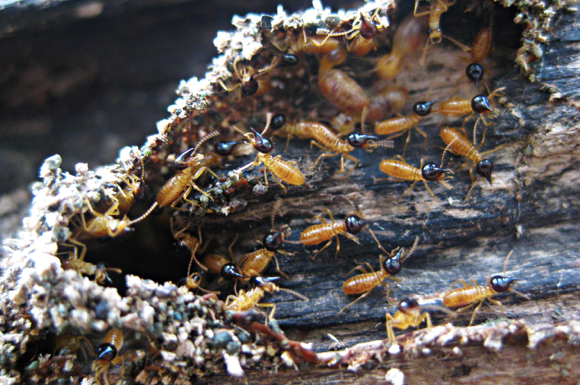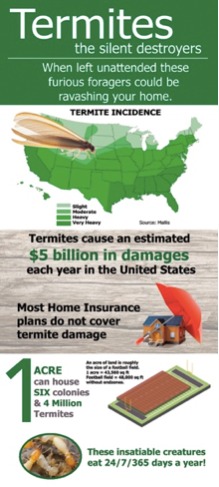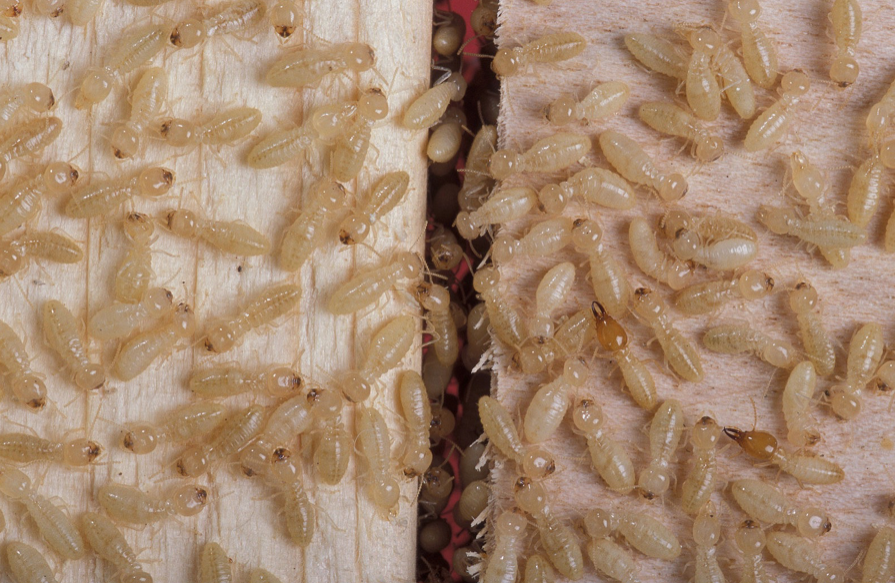
Termites. The word alone can send chills up the spines of Florida homeowners. What’s scary is just how much homeowners don’t know about termites but are too scared to ask. Knowing the signs of a termite problem can help you prevent an infestation and save you thousands of dollars in repairs. Stick with us and we’ll uncover the most important things you need to know about termites.

What You Should Know About Termites
Where do termites live?
Termites love warm, humid weather. They like to avoid cold temperatures, which is why you won’t find any termites colonizing Alaska.
Is my Florida home at risk for termites?

Florida is known for its high humidity and warm climate. This makes our state the perfect location for termites to breed, colonize, and destroy homes.
How much damage can termites do?
These ugly pests cause approximately $5 billion in damages across the United States every year. What does that mean for you? The average treatment and repair costs per home are just over $8,000.
What do termites look like?
Termites are small insects that are sometimes confused with ants. They can be white, brown or black, depending on the type of termite and their role in the colony.
Schedule a free inspection to know for sure.
I thought termites had wings…
This is partially true. Only termites who are in their reproductive stage (alates) have wings and can fly. A colony produces alates, also known as swarmers when it is about 3-5 years old. These swarmers leave their home colony to start ones of their own in a new location. Alates are sometimes confused with carpenter ants, which also have wings.
Why should I be worried about termites?
Your home is likely your largest investment and termites are a major threat to that investment. Something you might not know about termites is repairs due to their damage is not covered by most home insurance plans.
I’ve heard homes in my neighborhood have termites. How can I protect my house?
If you know your home is currently free from termites, it still is at risk for being swarmed by active ones nearby. An effective termite preventative plan can keep them from infesting your home. Contact Superior Spray to learn more about termite preventative options for your home.
How can termites get into my home?
One thing most people know about termites is they love to eat things made of wood. They are drawn to it like magnets. Therefore, all untreated wood inside your home is at risk for termites. They can enter through the tiniest of cracks in your foundation, bricks and mortar and other openings. Termites even use landscaping mulch or improperly stored firewood as ways to enter your home.
Termites only eat wood, right?
You might be surprised to learn that termites actually eat cellulose. Cellulose of course, is found in wood, but also in plants. The lumber in your house is a tasty main course for termites. However, once they are inside they’ll also use their incredibly strong jaws to chew through things such as insulation, plastics, carpet, and furniture.
Do I need to be concerned with termites if I live in a stucco home?
Yes. Termite problems are common in stucco homes too. In many stucco homes, the exterior finish extends beneath the soil. This leaves a small space between the foundation and the stucco finish, which permits termites to enter. Sometimes stucco finishes have a base layer of foam board that also extends beneath the soil level. Once termites gain access to the foam, they can go anywhere within the structure.
How can I treat my home for termites?
The only way to guarantee your home will be free of termites is through professional treatment and prevention. Termites can reach deep into the structure of your home. Attempting to exterminate them yourself is not advised. If you discover termites or suspect you have termites, you need to call a professional. Superior Spray offers FREE Termite Inspections. Call us today to schedule yours (863) 682-0700.
How fast can termites reproduce?
A termite queen can lay a thousand eggs in a single day and well over a quarter of a million eggs in a year.
What You Should Know About Termites in Florida

Most termites in Florida are subterranean termites which includes the incredibly destructive Formosan species. Termites are dependent upon each other for survival and live in large colonies that revolve around the Queen and her King. Their colonies also include soldiers, workers and eventually reproductive alates.
Subterranean Termites
As their name states, subterranean termites live underground; sometimes up to several feet underground. These termites need to maintain contact with soil and moisture. Like their relatives, the Formosan termite who is also of the subterranean species, they create mud tubes to get themselves into your home. Subterranean termite species are found in every U.S. state except Alaska, though they are more common in humid, southern states like Florida.
Formosan Subterranean Termites
Formosan termites are a species of subterranean termites. These wood munchers are always hungry and eat 24/7. Formosan termites boast the largest colonies of any termite species in North America. Other subterranean species can have over a million termites in a colony, but Formosan colonies have up to 15 million! The workers in these colonies chew up wood, then regurgitate it to feed the others. They use their shelter, and mud tubes to maintain ideal temperatures and hide from predators. Their eating habits entail burrowing into pieces of wood and eating only the soft portions along the grain. This particularly invasive species is primarily found in the Southeastern U.S. and you guessed it, they are rampant in Florida.
How To Recognize A Termite Infestation
- Swarming termites. Look for them near windows, doors, vents and lighting fixtures.
- Dropped or shed wings. Termites will shed their wings after finding a new home. All of the wings will be similar in size.
- Mud tubes or tunnels about the width of a straw.
- Hollow wood. Termites eat wood from within. Tap suspected wood with a screwdriver handle and listen for a hollow sound.
- Termite droppings are wood colored and about the size of a grain of coarse sea salt.
- Wood, or other surfaces that appear warped or blistered due to termite activity below the surface.
What You Should Know About Preventing A Termite Infestation
- Eliminate moisture by fixing pipes, A/C units, and other leaky fixtures.
- Repair cracks in your home’s foundation with caulk. Make sure to check utility lines and pipes as well.
- Keep plants and mulch well maintained. Mulch should never touch your home.
- Store wood on a non-wooden platform and maintain a few feet of space between it and your home.
- Dispose of scrap wood from projects and yard debris such as tree limbs.
- Use correctly sized screens on exterior vents.
- Keep an eye on outdoor wooden structures (dead trees, mailbox posts, swing sets, bird feeders, etc) for signs of termites.
Request Service
Request a Free Estimate
Fill out the form below. This form will take less than a minute to complete.
* indicates required fields
Request Service
Thanks for contacting us! We will get in touch with you shortly.
There was an error sending your message. Please try again later.
ABOUT SUPERIOR SPRAY
Superior Spray Service Inc was founded by Kevin Blanks in 2003 and is now one of the leading pest control companies in the State of Florida; offerings a full range of indoor / outdoor pest control including termite control, aquatic pest control, mosquito control, lawn / shrub / tree spraying, moss removal, and tree injections.
CUSTOMER CARE
Copyright 2024 © Superior Spray Service, Inc.

